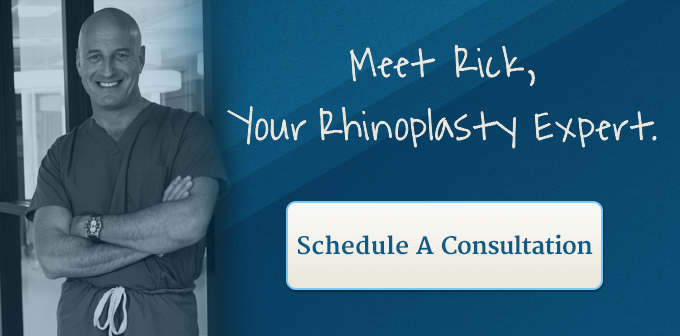Open rhinoplasty recovery tends to vary on an individual basis. Each patient has their own rate of healing, their own concept of pain and their own level of discomfort. Understanding that your open rhinoplasty recovery timeline may be different from other people’s will help you through the recovery process. An open rhinoplasty recovery starts before the surgery even begins. By following guidelines, you can help to ensure that your recovery is successful.
You can help ensure the best results by taking care of your body and your nose. In fact, you may be surprised to discover that although most patients are worried that the pain of recovery will put them out of commission, the majority don’t experience a lot of pain after surgery. Actually, many people don’t even need to take their prescribed pain medications. However, there can be a lot of discomforts, and the patients who have optimal recovery experiences are the ones who have properly prepared before the surgery even takes place.
The Difference Between Closed and Open Rhinoplasty
The difference between an open and closed rhinoplasty procedure involves the placement of the incision. For an open rhinoplasty, the incision is placed across the columella. The columella is the tissue between the nostrils, on the underside of the nose. The skin is then lifted back for the procedure to take place. In a closed procedure, the incision is placed inside the nose.
Depending on your unique rhinoplasty needs, as well as the desired outcome of the procedure, your cartilage and bone will be restructured and manipulated. Some people have more cartilage than others. Other people have more bone. Often people fear that their nose will be broken. While it is necessary to reset the bone for some desired results, this step may not be needed for people that have more cartilage. An open rhinoplasty is generally the preferred technique for working on the nasal tip. It also allows your surgeon to have maximum visibility and access to the nasal structure, without altering the existing structure of the nose.
How to Prepare for Open Rhinoplasty Recovery
Before your surgery, your surgeon will give you a packet of information to help you understand the open rhinoplasty recovery process. The recovery process actually starts before surgery and will include a pre-op exam to ensure the best possible outcome.
Your doctor may also give you other directions based on the findings from your pre-op exam session, as well as information about medications and preparing for your surgery. Be sure to read the packet; your body needs to time to prepare for the procedure so that your recovery will be better after surgery.
Pre-Surgery Open Rhinoplasty Guidelines
It may surprise you to learn that the best way to have an easy open rhinoplasty recovery is to start the healing process before your surgery date. When your surgeon makes recommendations, asks questions about your health and prescribes medications, take advantage of the information. Most people don’t have the time or the inclination for a lengthy recovery process, so starting on a regimen before surgery can help achieve the best results afterward.
Prior to surgery, stop taking certain medications and supplements that can interfere with your healing, including aspirin, vitamin E and fish oil. These supplements notoriously cause your blood to thin, which serves as an inconvenience for the surgeon. You should continue to take any prescription medications, though, unless your surgeon tells you otherwise. Your surgeon may also recommend supplements in order to encourage healing.
Pick up any prescriptions, medications and healing aids that have been recommended. This includes pain medications and tools like a wedge pillow that help you sleep upright, as well as ice packs or frozen vegetables that can be molded to fit over your nose to minimize swelling.
You should also pack a post-surgery bag and include items like a button-down shirt that you can easily take on and off. Also, find someone to be your designated helper for your first few days. You will have a better chance at a comfortable and flawless recovery by following all of these pre-operative instructions.
Stages of Open Rhinoplasty Recovery
After surgery, you will go through a few stages of open rhinoplasty recovery, some of which will pass easier than others.
Stage 1: The First Hours of Open Rhinoplasty Recovery
Following your open rhinoplasty, you may experience some pain, so be sure to take your painkiller prescriptions. You may also feel nauseous and will definitely be very congested and stuffed up. The nasal irrigation techniques in the instructions from your doctor will help, as will sleeping upright on a wedge or stack of pillows. Sleeping this way will make mouth breathing easier and minimize swelling and bruising.
After spending the first day in bed, you’ll be able to move around on the second day — just be sure not to bend over or blow your nose. This may also be the day that your surgeon removes any packing in your nose, which will definitely make you feel better.
Stage 2: The End of the First Week of Open Rhinoplasty Recovery
You’ll continue to feel out of sorts for the first week, but by the end of it, there will be good news to make you feel better. Your splint will come off and much of your swelling and bruising will have dissipated enough that you can return to work or school the following week.
You will have to continue to avoid the sun by wearing a hat and shades, and you won’t be able to resume your usual gym activity or sports quite yet.
Stage 3: The Week After Open Rhinoplasty
Some patients may still be taking things easy for another week, but for the most part, you’ll be back at work. You will still need to be vigilant about avoiding the sun for the next few months and continuing to avoid strenuous activity.
Stage 4: The Next Few Weeks of Open Rhinoplasty Recovery
As time passes, more and more swelling will resolve so that you can begin to see the final shape of your new nose. The tip takes the longest to heal, so it may still be a few weeks out before you see any changes. Around a month, or possibly less, your surgeon will clear you so that you can start engaging in your usual sports and physical activity, although contact sports are still off limits without special permission and wearing a protective mask.
Stage 5: The Months After Open Rhinoplasty Recovery
You will start to see real progress in the several months after your open rhinoplasty, as your recovery continues. Swelling will continue to go down and your nasal tissues will adjust to their new size. You may still experience some slight numbness, but the sensation will start returning.
Open Rhinoplasty Scarring
Many patients are concerned that an open procedure will result in too much scarring. The truth is that both procedures require scarring. For an open procedure, your skilled surgeon will find a location to make the incision the least noticeable when finished with the procedure. Using a careful closing technique minimizes the appearance of the scar and in most cases will not be visible.
The reason for minimal scarring is that your surgeon will use a V-Plasty incision. A V-Plasty incision minimizes the risk of your scar being visible. In fact, many patients will not even be able to see the scar themselves as this technique results in a nearly invisible scar.
There is often a misconception that rhinoplasty is only to make a nose smaller or narrower. Even in such cases, additional material is sometimes needed to create the desired result or solve the existing structural problem. Sometimes cartilage from the nose can be moved to build up the nose. In other cases, cartilage may be needed from elsewhere. Usually, cartilage is found from the ear. This doesn’t create a visible scar because the incision is made behind the ear, where glasses go on those who wear glasses. Other times, the doctor may opt to use rib, although this can have more risks. For some patients, an FDA approved material may be used as an implant. The surgeon will explain the pros and cons and risks of all options based on your needs.
Open Rhinoplasty with Cohen Winters
The full duration of open rhinoplasty recovery can last up to a year, and sometimes longer, depending on the individual. At this point, your scar should be pretty much invisible and you will likely have a final evaluation with your surgeon to ensure that you have healed completely. By this time, you will have resumed total function with your activities and be used to your new nose.


